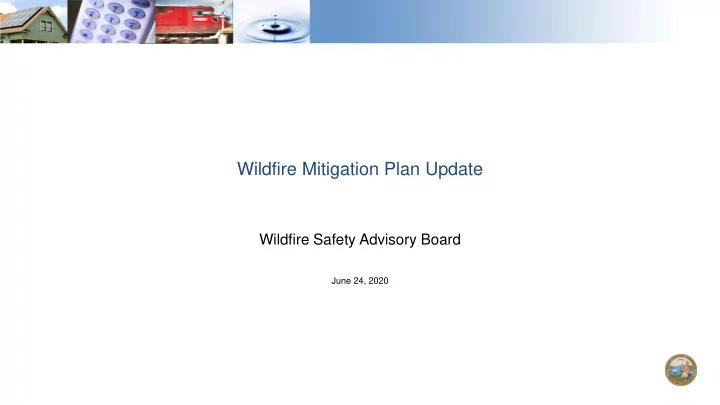

Wildfire Mitigation Plan Update Wildfire Safety Advisory Board June 24, 2020
2020 Wildfire Mitigation Plans: Draft resolutions issued 5/7 propose approval with conditions for all utilities; WSD issued final approval Action Statements (6/10); CPUC ratified resolutions (6/11) Today CPUC submission drafting WMP review Implementation and learning (December – February) (February – May) (June – November) Utilities draft wildfire mitigation plan Wildfire Safety Division (WSD) reviews Utilities implement mitigation plans and (WMP), which includes WMPs and assesses maturity via survey develop lessons learned that should be and WMPs included in annual updates Deep and broad subject expertise WSD monitors for compliance with required to review WMPs, including from WMPs, and incorporates lessons learned CPUC SED, CAL FIRE, and a range of into next year's guidelines other experts Utility plan to reduce Outcome and wildfire risk progress metrics An approved WMP is required for Utilities also complete a maturity survey safety certification to assess capabilities for managing wildfire risk 1
Guideline revisions had 3 objectives: Increased Improved Forward-looking standardization objectivity focus 2020 WMP Guidelines Revised to Support Broader Vision Improvements to be incorporated in 2021 and beyond Standardize information Enable systematic and Move utilities towards an collected on utility wildfire uniform review of qualitative effective long-term wildfire risk exposure and mitigation information mitigation strategy, with initiatives systematic tracking of improvements against long term targets 2
1. WMP comprehensively responds to guidelines and utility survey is complete WMP Evaluation Rubric 2. Initiatives in WMP are deemed technically feasible and effective in reducing wildfire risk Four factors to consider 3. Initiatives in 4. Sufficient WMP are an forward-looking efficient use ambition for of resources maturity growth 3
Evaluation Team consisted of 27 members • 18 subject matter, writing and project management experts from across the CPUC Evaluation Team • 9 subject matter experts from CAL FIRE 4
1. Approve 2. Approve with Conditions 3. Bear Valley- made no determination Class A Deficiency : Aspect of a plan is lacking or flawed. Remedy: Provide a Remedial Compliance Evaluation Plan in 45 days Process Results Class B Deficiency : Insufficient Detail or justification provided in plan. Remedy: submit a resolution to deficiency in a Quarterly Report within 90 days Class C Deficiency : Gaps in baseline or historical data. Remedy: Resolve by or within 2021 WMP Plan Update 5
2020 Wildfire Mitigation Plans: Common themes across 6 categories Risk assessment and mapping Grid hardening and asset management PSPS Little discussion of how models assess Unclear from WMPs how significantly Unclear from WMPs how VM and consequences of a given ignition and these initiatives reduce risk in terms of hardening work will quantifiably reduce how outputs are leveraged for decision- ignitions and PSPS events scale / scope of PSPS by increasing wind making threshold for initiating PSPS Vegetation Management Risk spend efficiency Timelines Labor constraints and recurring costs WMPs do not sufficiently demonstrate that Hard to assess utility compliance and may impede planned efforts they are allocating finite resources to progress if timelines and deployment initiatives that most effectively reduce plans are not described clearly Little to no analysis presented to show how wildfire and PSPS risk “enhanced” programs reduce ignitions over detailed and patrol inspections 6
Guidance Resolution Deficiencies • One Class A Deficiency: Lack of risk modeling to inform decision-making Guidance • 10 Class B Deficiencies Resolution (WSD- 002) • One Class C Deficiency Note: Additional Class A Deficiency common to 3 Large IOUs that require demonstration of effectiveness of increased vegetation management clearances 7
PG&E, SCE and SDG&E Summary 1 Class A Deficiencies 7 Class A Deficiencies 3 Class A Deficiencies • • • Vegetation management clearances Near Misses Aggregation of Initiatives • • Personnel shortages Vegetation management clearances • • 14 Class B Deficiencies High incidence of conductor failure Advancement in vegetation management 1 Class C Deficiencies 20 Class B Deficiencies 18 Class B Deficiencies 2 Class C Deficiencies 1 Class C Deficiencies SDG&E’s Plan met minimum requirements, SCE’s Plan met minimum requirements and PG&E’s Plan met minimum requirements, demonstrated understanding of risk, and presented activities to drive down wildfire risk demonstrated an understanding of top ignition presented initiatives to drive down wildfire risk drivers and actions to address those drivers Areas of Concern (selected): Areas of Concern (selected): Areas of Concern (selected): • • • Efficient use of resources Unclear use of risk models to drive Scale and scope of PSPS • • Diminishing returns Large allocation of spend on covered prioritization of mitigation activities to reduce conductor wildfire risk and PSPS 8
Liberty, PacifiCorp and Bear Valley Summary 0 Class A Deficiencies 0 Class A Deficiencies Wildfire Safety Division did not act on Bear Valley’s WMP. 4 Class B Deficiencies 5 Class B Deficiencies Wildfire Safety Division issued statement 1 Class C Deficiencies 2 Class C Deficiencies extending evaluation time period. Liberty’s Plan met minimum requirements, PacifiCorp's Plan met minimum requirements, Bear Valley submitted errata on May 22, 2020 initiatives addressed major risk drivers, good-faith initiatives addressed major risk drivers, good-faith that substantially altered the contents of their effort to address risk given exemption to date from effort to address risk given exemption to date from plan. S-MAP and RAMP requirements. S-MAP and RAMP requirements. Overall plan spend decreased from 247 million Liberty expects to have a process for evaluating PacifiCorp expects to have tools to quantitatively to 46 million new initiatives’ performance by 2023 estimate ignition risk by 2023 Areas of Concern (selected): Areas of Concern (selected): • • Continued development towards maturity Risk-informed decision-making to deploy initiatives 9
Plans Approved Without Conditions Horizon West undergrounding initiative faces delays 10
End
Recommend
More recommend